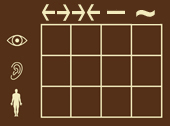Welded Together So Tightly in Your Mind
 Saturday, April 12, 2014 at 07:21PM
Saturday, April 12, 2014 at 07:21PM Elizabeth Hellmuth Margulis speaking with Anne Strainchamps about "Music and Memory," from To the Best of Our Knowledge, March 30, 2014:
 "Music is not really like a language. It's one of those metaphors that's really out there.
"Music is not really like a language. It's one of those metaphors that's really out there.
As I was growing up, I went to Interloken Arts Camp. Over the big stage there, they have it emblazoned in large letters: MUSIC IS THE UNIVERSAL LANGUAGE!
But maybe there are some things going on in music that aren't really the same as what's going on in language.
I'll give you some examples.
When we think back to what happened in a story somebody told us, we tend to remember the gist of what happened not the specific words they used to tell the story to us. But if we try to remember back to a song we listened to or a piece we really enjoyed, there's something about the actual, specific, sequence of notes that is still very present and verbatim in our memory. And in fact, really gripping.
There's a great example that Mark DeBellis uses in a book he wrote, where he asks—If you think about The Star Spangled Banner, and you think about the word Oh and the word you. Where those sung on the same pitch?
To answer that question, what you have to do is go back in and sing through the tune. You can't just duck in and get one little snippet. They're all welded together so tightly in your mind that one note seems to kind of inevitably spill out of the preceding one.
That tight connection from note to note is really an effect that is created through repitition."
~ Elizabeth Hellmuth Margulis, from "Music and Memory," To the Best of Our Knowledge, March 30, 2014.
See also:
Atomic Components of Narrative Elements
Attentional Fitness Strategies for Hearing Out
Margulis, E. H. (2014). On repeat: How music plays the mind. New York: Oxford University Press. http://www.worldcat.org/oclc/851068495
 Elizabeth Hellmuth Margulis,
Elizabeth Hellmuth Margulis,  hearing,
hearing,  language,
language,  memory,
memory,  mind,
mind,  music,
music,  storytelling
storytelling 









